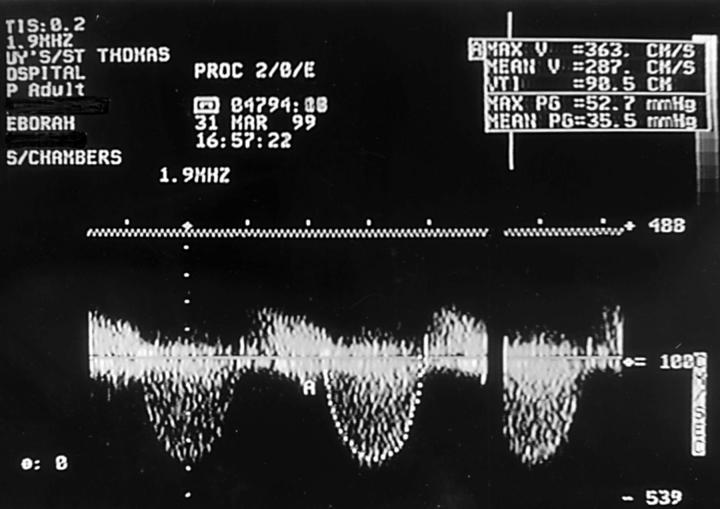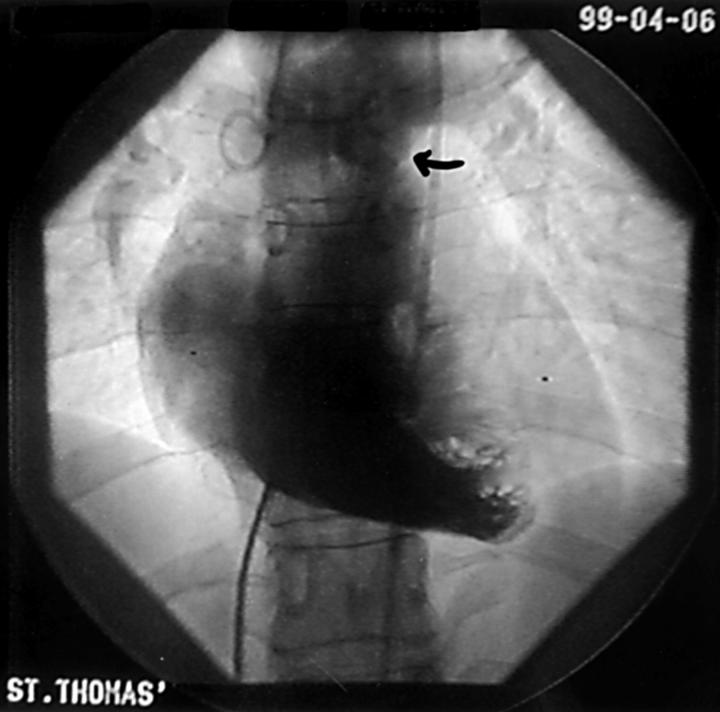Abstract
Half of all patients with carcinoid syndrome develop cardiac involvement. Patients who have cardiac involvement have a significantly worse prognosis than those without, and death can occur directly as a result of cardiac involvement. A case of carcinoid syndrome in a 38 year old woman with lesions in the liver, who presented with right sided valvar abnormalities, a dilated right ventricle, and right ventricular pressure overload, is presented. In order to palliate the patient's symptoms and to decrease right sided pressures before major abdominal surgery, balloon pulmonary valvuloplasty was performed at the time of cardiac catheterisation. This resulted in a reduction in the pulmonary gradient and right ventricular pressure. Following the procedure, the patient's symptoms were completely relieved. She went on to laparotomy where the lesions in the liver were excised without complication. Keywords: carcinoid syndrome; balloon pulmonary valvuloplasty
Full Text
The Full Text of this article is available as a PDF (84.1 KB).
Figure 1 .
Continuous wave Doppler through the pulmonary valve at transoesophageal echocardiography. A peak instantaneous gradient of 52.7 mm Hg−1 is present. This gradient was reduced to 8 mm Hg−1 after balloon pulmonary valvuloplasty.
Figure 2 .
Right heart angiography reveals pronounced narrowing at the level of the pulmonary infundibulum (arrow) before valvuloplasty which was performed during the same session.
Selected References
These references are in PubMed. This may not be the complete list of references from this article.
- Connolly H. M., Nishimura R. A., Smith H. C., Pellikka P. A., Mullany C. J., Kvols L. K. Outcome of cardiac surgery for carcinoid heart disease. J Am Coll Cardiol. 1995 Feb;25(2):410–416. doi: 10.1016/0735-1097(94)00374-y. [DOI] [PubMed] [Google Scholar]
- Denney W. D., Kemp W. E., Jr, Anthony L. B., Oates J. A., Byrd B. F., 3rd Echocardiographic and biochemical evaluation of the development and progression of carcinoid heart disease. J Am Coll Cardiol. 1998 Oct;32(4):1017–1022. doi: 10.1016/s0735-1097(98)00354-4. [DOI] [PubMed] [Google Scholar]
- Grant S. C., Scarffe J. H., Levy R. D., Brooks N. H. Failure of balloon dilatation of the pulmonary valve in carcinoid pulmonary stenosis. Br Heart J. 1992 Jun;67(6):450–453. doi: 10.1136/hrt.67.6.450. [DOI] [PMC free article] [PubMed] [Google Scholar]
- Hargreaves A. D., Pringle S. D., Boon N. A. Successful balloon dilatation of the pulmonary valve in carcinoid heart disease. Int J Cardiol. 1994 Jun 15;45(2):150–151. doi: 10.1016/0167-5273(94)90274-7. [DOI] [PubMed] [Google Scholar]
- McDonald M. L., Nagorney D. M., Connolly H. M., Nishimura R. A., Schaff H. V. Carcinoid heart disease and carcinoid syndrome: successful surgical treatment. Ann Thorac Surg. 1999 Feb;67(2):537–539. doi: 10.1016/s0003-4975(98)01313-7. [DOI] [PubMed] [Google Scholar]
- Oñate A., Alcibar J., Inguanzo R., Peña N., Gochi R. Balloon dilation of tricuspid and pulmonary valves in carcinoid heart disease. Tex Heart Inst J. 1993;20(2):115–119. [PMC free article] [PubMed] [Google Scholar]
- Pellikka P. A., Tajik A. J., Khandheria B. K., Seward J. B., Callahan J. A., Pitot H. C., Kvols L. K. Carcinoid heart disease. Clinical and echocardiographic spectrum in 74 patients. Circulation. 1993 Apr;87(4):1188–1196. doi: 10.1161/01.cir.87.4.1188. [DOI] [PubMed] [Google Scholar]
- Robiolio P. A., Rigolin V. H., Harrison J. K., Lowe J. E., Moore J. O., Bashore T. M., Feldman J. M. Predictors of outcome of tricuspid valve replacement in carcinoid heart disease. Am J Cardiol. 1995 Mar 1;75(7):485–488. doi: 10.1016/s0002-9149(99)80586-4. [DOI] [PubMed] [Google Scholar]




